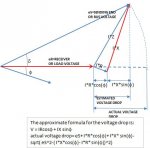JasonCo
Senior Member
- Location
- Houston, Texas
I have a homework question, I've already worked it out. I just want to make sure I got the right answer.
Scenario: For a load, the conductors consist of two 12 AWG THHN/THWN solid coated copper conductors connected to a 2-pole breaker in a 120/208-volt, 3phase, 4-wire panelboard. The circuit serves a load that draws 9.8 amps. The distance between the panel and the load is 150 feet.
Question: Refer to the scenario, Find the voltage dropped in the conductors. The voltage dropped in the circuit conductors is __ %?
A: 4.92
B: 3.0
C: 2.2
D: 4.5
E. 2.84
Okay, I'm reviewing for my test and looking back at old quizes I took in class. For WHATEVER REASON I circled E as my answer. But re-doing the question now, I'm getting A as my answer. Anyone able to double check my work?
Equation is 2KIL/CMA.
I did 2 x 13.1253 x 9.8 x 150 / 6530 = 5.9094 voltage dropped across the conductors. But question is asking the %. So I did 5.9094 / 120 = 4.92% as the answer.
Not sure if I'm doing the calculations correctly. If I need to double 150 feet. Or if I need to divide by 208 instead (which I doubt it because its 2-pole). But anyways, just wanted someone to hopefully proof me! Thanks a bunch for your help!!
Scenario: For a load, the conductors consist of two 12 AWG THHN/THWN solid coated copper conductors connected to a 2-pole breaker in a 120/208-volt, 3phase, 4-wire panelboard. The circuit serves a load that draws 9.8 amps. The distance between the panel and the load is 150 feet.
Question: Refer to the scenario, Find the voltage dropped in the conductors. The voltage dropped in the circuit conductors is __ %?
A: 4.92
B: 3.0
C: 2.2
D: 4.5
E. 2.84
Okay, I'm reviewing for my test and looking back at old quizes I took in class. For WHATEVER REASON I circled E as my answer. But re-doing the question now, I'm getting A as my answer. Anyone able to double check my work?
Equation is 2KIL/CMA.
I did 2 x 13.1253 x 9.8 x 150 / 6530 = 5.9094 voltage dropped across the conductors. But question is asking the %. So I did 5.9094 / 120 = 4.92% as the answer.
Not sure if I'm doing the calculations correctly. If I need to double 150 feet. Or if I need to divide by 208 instead (which I doubt it because its 2-pole). But anyways, just wanted someone to hopefully proof me! Thanks a bunch for your help!!


